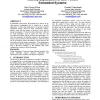Free Online Productivity Tools
i2Speak
i2Symbol
i2OCR
iTex2Img
iWeb2Print
iWeb2Shot
i2Type
iPdf2Split
iPdf2Merge
i2Bopomofo
i2Arabic
i2Style
i2Image
i2PDF
iLatex2Rtf
Sci2ools
DAC
1999
ACM
1999
ACM
Memory Exploration for Low Power, Embedded Systems
In embedded system design, the designer has to choose an onchip memory configuration that is suitable for a specific application. To aid in this design choice, we present a memory exploration strategy based on three performance metrics, namely, cache size, the number of processor cycles and the energy consumption. We show how the performance is affected by cache parameters such as cache size, line size, set associativity and tiling, and the off-chip data organization. We show the importance of including energy in the performance metrics, since an increase in the cache line size, cache size, tiling and set associativity reduces the number of cycles but does not necessarily reduce the energy consumption. These performance metrics help us find the minimum energy cache configuration if time is the hard constraint, or the minimum time cache configuration if energy is the hard constraint. Keywords Design automation, Low power design, Memory hierarchy, Low power embedded systems, Memory expl...
| Added | 13 Nov 2009 |
| Updated | 13 Nov 2009 |
| Type | Conference |
| Year | 1999 |
| Where | DAC |
| Authors | Wen-Tsong Shiue, Chaitali Chakrabarti |
Comments (0)

